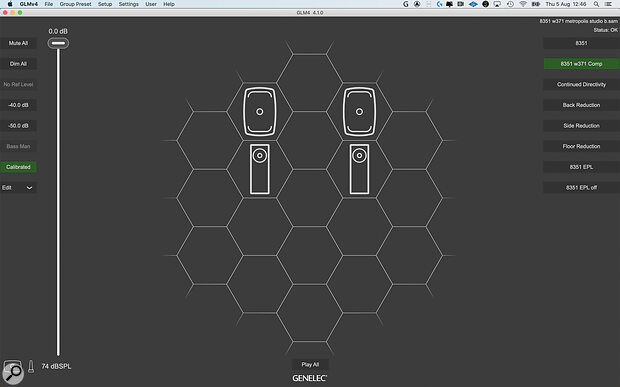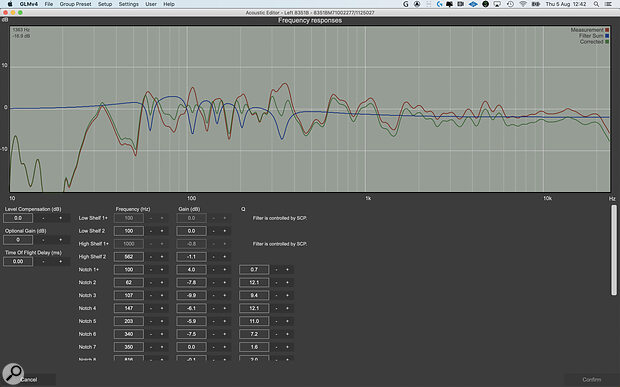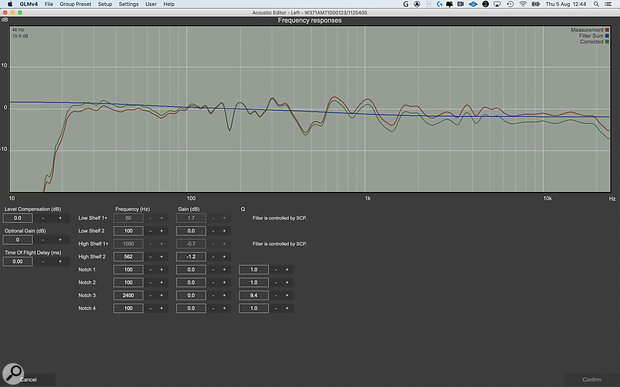Room Optimisation Calibration
Regardless of how many monitor or subwoofer channels a GLM system comprises, the process for creating room optimisation data for upload to the appropriate monitors is the same. The GLM 4.1 launch screen displays a hexagonal grid graphic that represents the monitoring space, as illustrated in Screen 1. Monitors connected (via the proprietary Genelec Ethernet‑based network) to the Genelec GLM USB interface appear in a list at the side of the hexagonal graphic and can be dragged into one of the boxes to represent its monitoring role (left, right, centre, surround, and so on).
 Screen 1: The GLM 4.1 launch page.
Screen 1: The GLM 4.1 launch page.
When the monitors are positioned, optimising each one is simply a case of placing the GLM measuring mic at the preferred listening position and pressing the AutoCal button. GLM will route a sine sweep test signal to each monitor or subwoofer in turn and upload the results from the measuring mic to the GLM cloud server, which intelligently decides on the appropriate EQ settings. GLM then uploads the EQ settings to each monitor taking into account the number of DSP‑based filters available in each. Screens 2 and 3 respectively illustrate the GLM correction EQ for the left‑channel 8351B alone and then the composite 8351B/W371A system. Being a room‑mode effect, the low‑frequency suck‑out between 40Hz and 50Hz on the 8351B alone wouldn’t be fixable by adding targeted gain, but is corrected perfectly when the W371A is added.
 Screen 2: The correction EQ graph for a single 8351B.
Screen 2: The correction EQ graph for a single 8351B.
If the studio space incorporates multiple listening positions (mix engineer, client sofa, producer desk...) then the measuring mic can be moved to a new position, the AutoCal process repeated and the new optimisation profiles saved. GLM 4.1 then makes it very easy to switch between listening positions. Similarly, in complex multichannel systems, monitors can be saved as groups so that if, for example, the same audio programme is being mixed for multiple formats (maybe stereo, 5.1 and Dolby Atmos), it’s a simple matter to create a group of monitors for each and switch between them. Once calibration is complete, GLM can then take on the role of a software‑based monitor controller where it offers pretty much all the functionality you’d expect of a hardware device.
 Screen 3: Correction graph for a full setup comprising two 8351Bs and a single W371A.
Screen 3: Correction graph for a full setup comprising two 8351Bs and a single W371A.
The W371A Woofer System
Moving away from GLM 4.1 for a moment, I’ll spend a few paragraphs describing the new W371A Woofer System. While, thanks to its sub‑25Hz low‑frequency roll‑off, it’s so very tempting to describe the W371A as a subwoofer, it’s really a very different animal. To begin with, rather than just fill in the lowest octave, the W371A can actually operate all the way up to 500Hz — well over two octaves higher than you’d normally expect the job of a subwoofer to be done and dusted. And furthermore, the W371A, thanks to its two widely spaced drivers, brings a significant element of low‑frequency dispersion control to the party. Conventional subwoofers are almost always exclusively omnidirectional devices.
Having mentioned the widely spaced drivers of the W371A I’ll now add a little flesh to those bones. The W371A is not small: it’s a 0.4m deep and wide rectangular black box that stands just over 1.1m tall and weighs a not insignificant 61kg. Use of the terms ‘stands’ is appropriate because in many installations the W371A is an appropriate height on which to place the 8351B (or the equally compatible 8341A/8361A). In being plain, black, and obstinately rectilinear in form, the W371A has little of the lavish industrial design style of the 8351B, but part of the justification for that I suspect is that maximising internal volume for electro‑acoustic needs trumps any softening of appearance.
Facing forward at the top of the W371A cabinet is a 365mm (14‑inch) diameter bass driver, and facing backwards at the bottom of the cabinet is a 305mm (12‑inch) bass driver accompanied by an adjacent flared slot reflex port. The two drivers operate in separate enclosures and are driven by 400W Class‑D amplifiers. Their combined role is to turn the 8351B (or again, 8341A/8361A) into a four‑way system, with their specific responsibilities, in terms of low bass to upper bass crossover integration and room optimisation, managed intelligently by GLM depending on the needs of the room optimisation and dispersion targets at each optimised listening position — hence the W371A being able to operate up to 500Hz. The result is that systems comprising the W371A and 8351B, (or 8341A/8361A), in addition to offering a remarkably flat and very wide‑bandwidth in‑room frequency response at multiple listening positions, can also offer multiple dispersion profiles all the way from around 60Hz up to frequencies where the 8351B itself begins to display cardioid characteristics.
The system dispersion control profiles I mentioned can be chosen to, for example, suppress floor or side wall reflections, or simply to continue, all the way down to low frequencies, the dispersion characteristics of the main speakers. The combination of GLM with the W371A and 8351B makes all this possible across multiple channels, with GLM doing all the difficult sums and making the decisions concerning exactly how, and at what frequency, the crossover between the 8351B and the W371A is best handled. It’s pretty much as if the composite speaker system of 8351B and W371A is intelligently designed by GLM on the spot to suit the specific room acoustics and needs of the user.
The system is undoubtedly a triumph of electro‑acoustics...
Home & Away
I mentioned earlier that the 8351B, along with the majority of Genelec’s monitoring products, incorporates an enclosure constructed from aluminium die‑castings. The die‑cast construction undoubtedly helps ensure that the enclosure makes minimal acoustic contribution in terms of panel resonance, but it also represents a pretty eye‑watering investment in terms of tooling costs, and that I think has some significant implication in terms of the market sectors and applications Genelec pitch their monitors towards. Once a decision has been made to invest huge sums of cash into tooling, it’s no good then aiming the product at a niche — rock & roll or EDM mix monitoring, for example. You need to attract customers from as broad a church as possible; from bedroom indie guitar pop bedroom studios to major, multichannel immersive experience stages. And as if to reinforce this idea, I had two contrasting opportunities to spend time listening to the 8351B and W371A. Firstly, a few weeks at home with just a stereo pair of 8351Bs and GLM, and secondly, a few hours in the control room of Studio B at London’s Metropolis Studios with a system comprising a stereo pair of 8351Bs, the W371A, and of course again with GLM.
Home listening first. The 8351B loan period coincided with a house move that left me working temporarily in a pretty small (3 x 3.5m) and minimally treated room, and for some monitors, especially those like the 8351B blessed with significant low‑frequency bandwidth, that would likely be a significant problem. Thanks to GLM and the point‑source nature of the 8351B, however, the small size of the room turned out to be relatively benign. Firstly, GLM effectively suppressed the low‑frequency room modes, and secondly, one of the advantages of point‑source monitors is that they don’t really care about listening distance so can be used effectively in the extreme nearfield. There comes a point with conventional multi‑way monitors where a really close listening distance can begin to render individual drivers subjectively apparent (mainly through the off‑axis cancellation nulls in the crossover region becoming more audibly significant), but with all the audio emanating from a single point in space that problem doesn’t occur.
My overwhelming subjective response to the 8351B, optimised for the room and primary listening position by GLM, was one of tonal neutrality and bomb‑proof professional competence. The 8351B exudes a sense of trustworthiness in that its subjective performance is completely without quirks or any particularly noticeable character — if it were an Instagram post there’d be no filter. Bass, despite the small room, but aided no doubt by GLM, was informative and clear with no obvious ported monitor traits. Midrange and high‑frequency performance was similarly satisfying, with great image focus and detail portrayal without any monitor‑borne artefacts. Those midrange mix details that we tend to get obsessed with — reverb tails and compression character, for example — were all easily audible and satisfyingly focused in the space between the monitors. The combination of a completely trustworthy and neutral tonal balance and outstanding midrange mix detail is, to my mind, one of the ultimate signs of a great monitor. You can often have one or the other, but both at the same time is much more unusual.
My overwhelming subjective response to the 8351B was one of tonal neutrality and bomb‑proof professional competence.
Metropolis Studios
Following my time with the 8351B at home, I decamped to Metropolis Studios to hear the combination of the 8351B and W371A in the Studio B control room. The system had been previously set up by Genelec, with GLM 4.1 configured to provide a few system response and dispersion options. Of course, being dropped into a less familiar environment to listen to an unusual monitoring system makes any definitive conclusion difficult to draw. Having said that, however, the experience left me with little doubt that the 8351B/W371A system is extraordinary. Bass bandwidth and level available from the W371A seemed subjectively unlimited, perfectly integrated with the midrange, and flawless in terms of pitch and dynamics. I listened to a wide variety of old favourites via Tidal, a couple of which I’d both mixed and played bass on, and heard countless elements that I’d simply never previously noticed: everything from new perspectives on how, say, reverbs integrate with the stereo image, to hearing significant instrumental or vocal performance details that I’d simply never been aware of before. It was seriously addictive.
 The Genelec 8351B/W371A setup installed at Metropolis Studio B.
The Genelec 8351B/W371A setup installed at Metropolis Studio B.
As I described previously, GLM provides the opportunity to select from various pre‑configured monitoring response and dispersion presets, and in Screen 3 some can be seen listed on the right. The presets include those that employ the dispersion control capabilities of the 8351B/W371A composite to suppress low/mid‑frequency floor, back or side wall reflections, and these in particular made for fascinating listening. The subjective differences between dispersion options weren’t apparent so much in tonal terms as they were in the way the system presented stereo focus and imaging. With side reflections suppressed, for example, the image seemed less expansive in terms of width but more explicit in terms of depth. But while the comparison of different presets was fascinating, I had some trouble deciding which one I preferred or which would offer the most value in terms of mix work. I think I’d need longer with the system, and probably an actual mix job to do, before I settled on a preference. I also suspect that 8351B/W371A dispersion control options might become somewhat more relevant in less well‑controlled listening spaces than a Metropolis control room.
Back to the more fundamental performance of the 8351B/W371A at Metropolis. The system is undoubtedly a triumph of electro‑acoustics and if I were lucky enough to be able to afford such a system I’d probably only hesitate for as long as it took to experience its few equally impressive competitors. I was left with a couple of questions, however. Firstly, if I were working in Metropolis Studio B with the 8351B/W371A, I’m not sure I’d ever feel the need to use the main monitors. And secondly, I wonder, when a monitoring system is so hugely capable in terms of revealing detail over such a wide bandwidth, how I’d ever be able to conclude that a mix is finished? I’m pretty sure I’d never know when to stop fiddling with it.
Alternatives
If I were in the fortunate position of considering a full 8351B, W371A and GLM 4.1 system, I would probably also want to hear the Kii Three BXT System, the Ex Machina Quasar, the Barefoot Sound MiniMain 12, and perhaps something more conventional like an ATC SCM100A or PMC IB2S.
Pros
- Extraordinary levels of detail, imaging and tonal accuracy over the full audio bandwidth.
- GLM 4.1 immensely capable yet easy to use.
- System able to self‑optimise for a wide range of installation environments.
- 8351B with GLM can work well in very small spaces.
Cons
- Other than the price, none.
Summary
The 8351B and W371A, combined with GLM 4.1, joins a very select group of products that can recalibrate expectations of what’s possible from a monitoring system.
Information
8351B £3599, W371A £7859. Prices are per speaker, including VAT.
Source Distribution +44 (0)20 8962 5080
8351B $4595, W371A $9995. Prices are per speaker.
Genelec USA +1 508 652 0900
